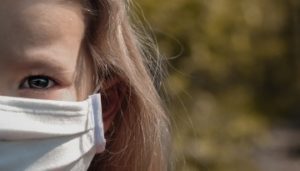As we prepare to close the books on what likely has been the most unusual school year in decades, it’s safe to say things will probably continue to look different next year. Some students will return to the classroom full time with social distancing measures in place, while others will begin the year with remote learning or a hybrid approach. Regardless of how the new school year begins, we can be sure of two things: there will be challenges, and, for children with disabilities, preparation will be essential for a successful transition back to the classroom. One of the biggest challenges for some of those children will be wearing a mask. These suggestions can help you to prepare your child.
Approach mask wearing like any other behavior.

As a teacher who has many years of experience with behavior modification, I think the best way to approach mask wearing is to treat it like any other behavior. Just because we are in the middle of a pandemic, we shouldn’t forget that research-based best practices are tried and true. So, before you sit down with your child, mask in hand, take these steps:
- Identify the behavior. The behavior we want to address is not just refusing to wear a mask but wearing it appropriately — over the nose and mouth, etc.
- Gather baseline data. In this case, that simply means seeing if your child will tolerate wearing a mask and for how long so you have a starting point as you move forward. This should not be stressful for you or your child. If the child refuses, do not push or force them to put the mask on.
- Next, investigate the function or the “why” of the behavior. If you can, ask your child, “Why won’t you wear the mask?” or “What makes wearing the mask uncomfortable?” If your child is not able to tell you, think about things you already know about them. Could it be a sensory issue? Does wearing one fog up your child’s glasses? Is it a change in routine? What else might cause your child to refuse?
- Identify the replacement behavior. In behavior modification, the only way to move forward is to teach a new replacement behavior. In this case, replacing not wearing a mask with wearing one.
- Identify what motivates/reinforces your child. Choose a reinforcement that will increase the likelihood that the new/desired behavior will repeat itself. Be consistent with the reinforcement and provide it, along with specific verbal praise, after each successful display of the new behavior. If the behavior is not increasing, try a new reinforcer.
- Finally, remember behavior change takes time. With preparation, practice, and consistent reinforcement, the behavior will change, and tolerance will increase.

Develop a plan to teach the new behavior.
Now that you have identified what the new behavior is, why the behavior isn’t occurring, and what the reinforcer is, you can develop a plan to teach the new behavior. I have not been in the classroom during this pandemic, so I reached out to my friend and former co-teacher, Julie Quinn, who has more than 16 years of experience teaching autistic children, to discuss best practices. I also reached out to my friend and mom of a little guy with Down syndrome, Ashley Barlow, to see if these best practices translate to the home setting. These are the strategies we found to help you teach your child to wear a mask.
- Keep in mind sensory challenges. Working on sensory tolerance for mask wearing looks the same as it does with other tasks. The end goal remains the same: tolerating the non-preferred sensory activity. Ways to work on sensory tolerance include:
- Buying several types of masks with varying textures, thicknesses, etc. and allowing your child to choose the one that is best for them.
- Think about how the mask smells and if your child engages in oral stimulation, you may want to pack extra masks so that they can have access to a dry/clean mask throughout the day.
- If your child will absolutely not tolerate a mask, see if a face shield or other protective equipment may be an acceptable alternative.
- Use visuals. Visuals help remove uncertainty from a new task. Using social stories, whether in print or video, will allow your child to normalize mask wearing and see how it applies to their daily lives. Many organizations provide COVID-19 and mask resources for families, including children’s hospitals and local/national autism chapters. Some organizations like Sesame Street, the Autism Society of America, and Cincinnati Children’s also provide resources, including social stories and videos, to help kids with autism adapt to wearing face masks and address other realities of living through a pandemic.
While there are many great social stories out there, I prefer to make social stories with pictures featuring the student and people/places relevant to their lives. You can do this in a simple word document, on sites such as Book Creator, or simply by gluing pictures on paper and handwriting the story. This does not have to be a Pinterest-worthy project, just a way to make mask wearing relatable for your child. In addition to social stories, a first-then board (first you wear your mask; then you (x)) or a visual schedule showing a child when the mask will need to be worn, when a mask break will be, etc. can also be used to decrease the anxiety of mask wearing.
- Try modeling. Video modeling is an evidence-based prompting strategy that can feature the learner or another person demonstrating the desired behavior. Once the video is recorded, the child can watch the video back as a prompt to complete the task. Other modeling strategies include using a familiar person to model the behavior while the child watches or having the child complete the task while looking in the mirror.
- Teach the new behavior in chunks. Breaking a task into smaller more manageable tasks creates more opportunities for success and reinforcement. Start with a simple tolerance task like holding the mask or putting the mask on a stuffed animal. Slowly work up to touching the mask to your child’s face, and finally having your child wear the mask for any duration during a preferred activity and later generalizing it to other activities and nonpreferred tasks. When working on duration, use a visual timer, which can help manage the expectation.
- Remember your village. Wearing a mask will be a skill that is generalized across settings. If you are having difficulty teaching this task at home, reach out to your child’s teacher, ABA therapist, occupational therapist, etc., for assistance.
Parenting during a global pandemic has presented a unique set of challenges. As we prepare for summer break, we should all take a breath, reflect on the past year, and give ourselves (and our children) a pat on the back. It’s been a wild ride.
 Carla Wyrsch is a devoted educator and advocate for children with disABILITIES with over 18 years of experience. Currently, she is a content creator and guest blogger for Partners in PROMISE, an education and advocacy group working on behalf of military special needs children. Additionally, she is a certified special education teacher with a background in applied behavior analysis. Her experience spans various settings, including residential treatment facilities, military bases, public schools, and the Cleveland Clinic Children’s Lerner School for Autism.
Carla Wyrsch is a devoted educator and advocate for children with disABILITIES with over 18 years of experience. Currently, she is a content creator and guest blogger for Partners in PROMISE, an education and advocacy group working on behalf of military special needs children. Additionally, she is a certified special education teacher with a background in applied behavior analysis. Her experience spans various settings, including residential treatment facilities, military bases, public schools, and the Cleveland Clinic Children’s Lerner School for Autism.



 Carla Wyrsch is a devoted educator and advocate for children with disABILITIES with over 18 years of experience. Currently, she is a content creator and guest blogger for Partners in PROMISE, an education and advocacy group working on behalf of military special needs children. Additionally, she is a certified special education teacher with a background in applied behavior analysis. Her experience spans various settings, including residential treatment facilities, military bases, public schools, and the Cleveland Clinic Children’s Lerner School for Autism.
Carla Wyrsch is a devoted educator and advocate for children with disABILITIES with over 18 years of experience. Currently, she is a content creator and guest blogger for Partners in PROMISE, an education and advocacy group working on behalf of military special needs children. Additionally, she is a certified special education teacher with a background in applied behavior analysis. Her experience spans various settings, including residential treatment facilities, military bases, public schools, and the Cleveland Clinic Children’s Lerner School for Autism.